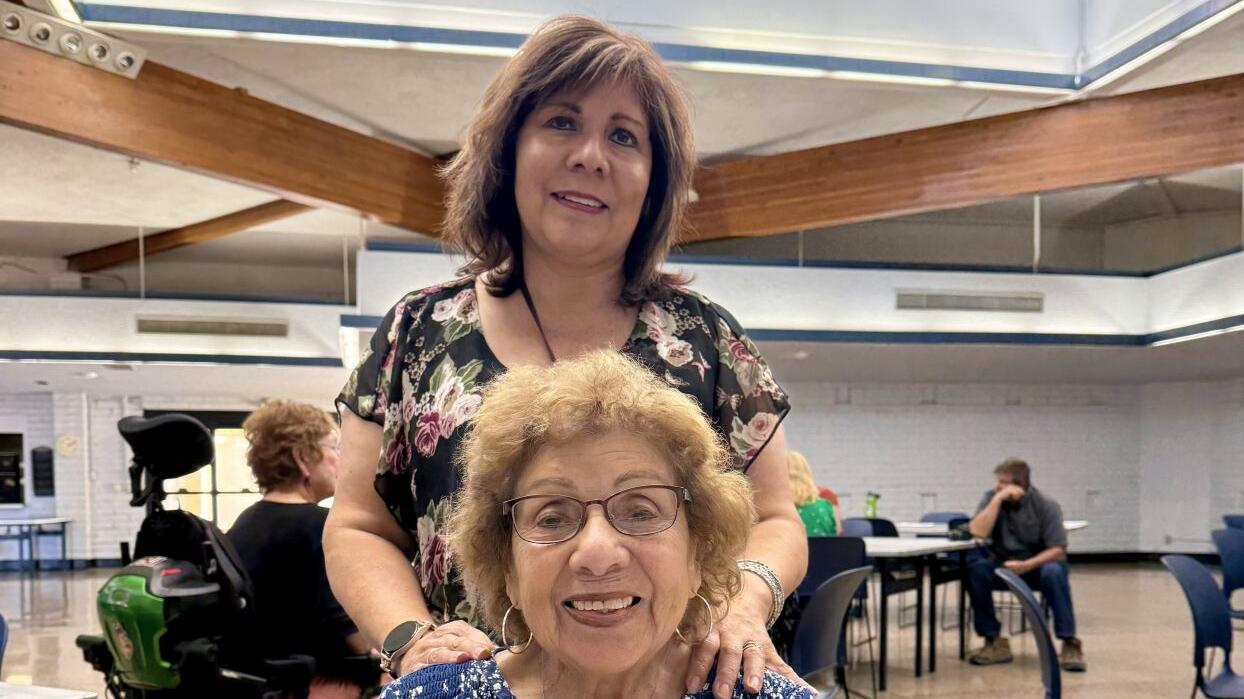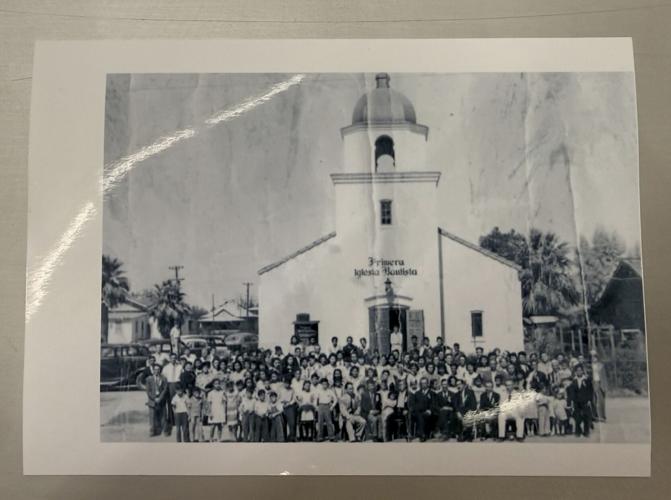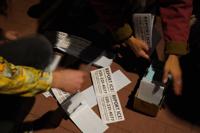
Emma Gordoa and her daughter Estella Martinez attend the Hispanics in Phoenix event on Aug. 16, 2025. (Ghadiel Navarrete / CALÓ News)
As of 2025, only 28 buildings across Phoenix are officially recognized as having historic ties to the Latino community, despite nearly half of the city’s population identifying as Hispanic and Latino. A local coalition of city workers, surveying experts and oral historians is looking to change that.
The city of Phoenix’s Historic Preservation Office joined Arizona Barrio Stories (AZBS) and Westland Consulting in hosting its second Latinos in Phoenix event on Saturday. Its goal is to expand the Hispanic Historic Property Survey, a 2006 survey that identified locations in Phoenix important to Hispanic development from 1870 to 1957.
The city identified parks, churches, cemeteries, homes and other buildings in the south side of Phoenix and ultimately added 10 sites to the Phoenix Historic Property Register, including Harmon Park, Sacred Heart Church and the Sotelo-Heard Cemetery.
The locations demonstrated the influence and growth of the Latino community in the region. But researchers agreed the project also focused on telling the stories of the people who gave life to those structures.
“It wasn’t just about buildings,” Jean Reynolds, one of the leading researchers, explained. “We collected oral histories, dug through archives and walked neighborhoods to connect the stories to the places. That initial work gave Phoenix the tools to decide which properties could be recognized, commemorated or preserved.”
When looking at historic properties, Latino heritage locations have been severely underrepresented. Phoenix’s Historic Preservation Office says that out of its 281 Historic Property Register, only 28 have Latino connections. Meanwhile, there are only 15 national historic locations in Phoenix that have Latino ties.
“Early preservation efforts have very much focused on a combination of things [such as] high-end architecture and then really looking at the most prominent individuals, which in sort of the narrative of history has typically been white males and sort of that European narrative,” Helana Ruter, historic preservation officer with the city of Phoenix, said. “That's something that [Phoenix] wanted to address starting in the early 2000s,” and now wants to look into once more to add additional properties and stories they might have missed.
Factors that contribute to preservation efforts also include high costs and the length of the application process for a building to obtain historical status. One of the firms leading the survey, Westland Consulting, has found a way to make it easier for buildings and locations to obtain the status.
“It's a pretty rigorous process. It can take about a year to do. It is very expensive and most people cannot afford to do that,” Jennifer Levstik, project manager at Westland Consulting, said. “We, as a group, can now make it affordable for somebody to get the property registered and recognized in the national register.”
The revamped survey has identified 44 locations around Phoenix that can be potentially added. Irma Payán, community archivist with AZBS, has been instrumental in collecting oral stories and identifying key locations. AZBS is a local non-profit that was launched as a Facebook group during the pandemic, creating a digital space for Latino Arizonans to share stories of the barrios where they grew up.
Payán said her efforts to contribute stem from her love for the original study, as the areas it focused on were in south Phoenix, where she grew up.

Primera Iglesia Bautista, old picture. (Courtesy of Emma Gordoa)
“I could not put it down to the way they captured different information about people and places.” Payán said. “It was fascinating to me, because I grew up around these places. Now, as an adult, I think we need to reach out to other people to let them know about these people and places. There's many places out there that need to be preserved.”
One location that is looking to be preserved is the Phoenix Christian Center, located at 1005 East Washington Street, just east of Seventh Street, on the property of the Primera Iglesia Bautista. Emma Gordoa and her daughter Estella Martinez attended Saturday's event looking to share Gordoa’s stories and the impact the center had in the 1900s.
Ninety-year-old Gordoa moved to Phoenix in 1958 to join the center as a missionary and helped in the children’s ministry. She said the center helped the residents of the barrio because it offered a range of activities, including recreation for adults and youth as well as a focus on academics.
“The purpose of the center was to help and serve the people of the community. During this time, many [Mexicans and their descendants] lived in the community. The center provided education, English and health classes and Christian education,” Gordoa said. “ [It had] a Preschool and Kindergarten program and homework help along with other activities and sports for the youth.”
Gordoa said the center would serve as the hosting ground for community meetings for years until the 1960s, when the city of Phoenix began buying the properties in the barrio where many of the church’s congregants lived.
“Soon the people of the community moved out of the area and the children were not able to attend the center,” Gordoa said. “In 1967, the first Mexican Baptist Church bought property on the west side and moved. This caused less activity at the center and within time, the doors of the center closed.”
To date, the building remains boarded up. Gordoa is hopeful the city will restore and designate it as a historic site.
As the city continues its survey, residents are encouraged to attend the next community event on Nov. 15 at South Mountain Community College at 7050 South 24th Street. Residents are encouraged to participate, bringing original documents, artifacts or stories to share with the surveying team, or they can submit information online.
“Regardless of who you are, where you come from or what kind of work you did, we are all an important part of the community,” Reynolds said. “All those histories are equally significant, and it’s important to keep that in the forefront of people’s minds.”
Ghadiel Navarrete is a freelance reporter based in Phoenix, Arizona. He graduated in 2024 from ASU with a bachelor’s in Political Science and Journalism.














(0) comments
Welcome to the discussion.
Log In
Keep it Clean. Please avoid obscene, vulgar, lewd, racist or sexually-oriented language.
PLEASE TURN OFF YOUR CAPS LOCK.
Don't Threaten. Threats of harming another person will not be tolerated.
Be Truthful. Don't knowingly lie about anyone or anything.
Be Nice. No racism, sexism or any sort of -ism that is degrading to another person.
Be Proactive. Use the 'Report' link on each comment to let us know of abusive posts.
Share with Us. We'd love to hear eyewitness accounts, the history behind an article.